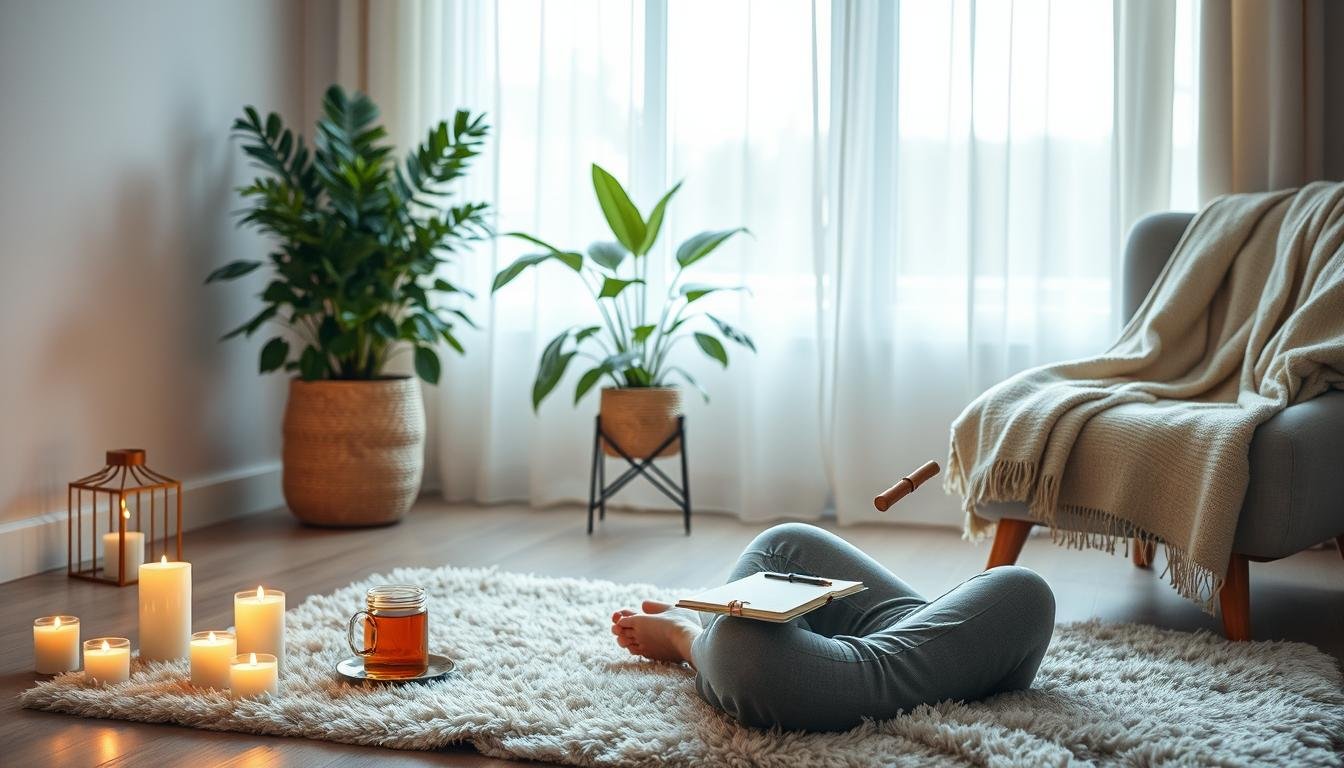Have you heard of eco-anxiety? It’s the worry, fear, and distress from environmental impacts of climate change. With our planet changing, feeling overwhelmed is common.
But, there are natural strategies to handle climate change stress. Simple daily practices can lessen anxiety and boost your well-being.
Key Takeaways
- Understand the concept of eco-anxiety and its effects on your well-being.
- Discover simple, natural strategies to manage climate change stress.
- Learn how to incorporate sustainable practices into your daily life.
- Find out how to reduce feelings of anxiety and promote well-being.
- Explore the connection between environmental anxiety and your mental health.
Understanding Eco-Anxiety and Its Impact on Mental Health
Climate change has made many of us worry about the future of our planet. This feeling is shared by people all over the world. It’s called eco-anxiety, and it’s a big concern for our mental health.
What Is Eco-Anxiety?
Eco-anxiety is feeling scared or worried about the environmental crisis. It makes you think about the future in a scary way. Even though it’s not in the official mental health books, experts say it’s real and important.
Recognizing Symptoms
People with eco-anxiety worry a lot about the environment. They might feel hopeless or feel like they have to do everything to save the planet. They might also get sick or tired because of the stress.
Some people get so tired of hearing bad news about the environment that they start to feel numb. This is called climate change fatigue.
The Connection to Climate Change
Climate change makes eco-anxiety worse. Knowing about global warming and its effects on our planet can be very scary. It’s normal to worry about things like more natural disasters and rising sea levels.
It’s important to understand how climate change affects our minds. By facing our fears, we can start to feel better. We can work on being strong in the face of climate change.
The Importance of Mental Resilience
In uncertain times, mental resilience is key to staying well. It helps us deal with eco-anxiety. Knowing its value is essential.
Building Strength in Uncertain Times
Mental resilience grows through coping strategies and adapting to tough situations. Techniques like mindfulness, social support, and self-care help.
Mental resilience isn’t about avoiding stress. It’s about managing it. This way, we can handle climate change’s emotional effects better.
Why Resilience Matters
Resilience lets us tackle challenges head-on, not just react. It keeps our mental health strong, even when things get tough.
The table below shows how resilient and non-resilient responses differ to climate stress:
| Characteristics | Resilient Response | Non-Resilient Response |
|---|---|---|
| Coping Mechanisms | Active coping strategies (e.g., problem-solving, seeking social support) | Avoidance or denial |
| Emotional Regulation | Effective emotional regulation (e.g., mindfulness, self-care) | Dysregulation (e.g., anxiety, depression) |
| Adaptability | Flexibility and adaptability in the face of change | Rigidity and resistance to change |
Strategies for Enhancing Resilience
Here are ways to boost mental resilience:
- Practicing mindfulness and meditation
- Engaging in regular physical activity
- Building and maintaining social connections
- Developing problem-solving skills
- Engaging in activities that promote a sense of purpose and meaning
By using these strategies daily, we can improve our mental resilience. This helps us face climate change’s challenges more effectively.
Nature Therapy: A Natural Solution to Stress
Nature therapy is a natural way to deal with stress and anxiety caused by climate change. It helps people find comfort and strength in nature. This approach is becoming more popular as people look for ways to handle environmental worries.
What Is Nature Therapy?
Nature therapy, or ecotherapy, means spending time in nature to boost mental health. It includes activities like walking in parks and wilderness therapy. The goal is to help people feel connected to nature again, finding peace and balance.
Benefits of Spending Time Outdoors
Being outside is good for your mind, helping with anxiety and depression. It can also make you feel happier, smarter, and more connected to the world. As Richard Louv said, “In wildness is the preservation of the world.”
“The clearest way into the Universe is through a forest wilderness.”
Techniques for Incorporating Nature into Daily Life
Adding nature therapy to your daily life is easy and beneficial. Here are some ways:
- Taking short walks in nearby parks or green spaces
- Engaging in outdoor activities like gardening or birdwatching
- Practicing mindfulness or meditation outdoors
By making nature a part of your day, you can use its healing powers. This helps you deal with eco-anxiety better.
Mindfulness and Meditation Practices
Mindfulness and meditation help you manage eco-anxiety. They connect you with yourself and nature. Adding these to your day boosts your resilience and supports sustainable self-care.
Understanding Mindfulness
Mindfulness means being fully in the moment. It’s about noticing your thoughts, feelings, and body without judgment. This practice brings calm and clarity, even when things are uncertain.
To get mindfulness, know its key points:
- Focus on the present moment
- Don’t judge your experiences
- Stay curious and open
Simple Mindfulness Exercises
Starting with simple exercises can help with eco-anxiety. Here are a few:
- Mindful breathing: Just watch your breath without trying to control it.
- Body scan: Lie down or sit, focusing on each body part from toes to head.
- Mindful walking: Notice your feet touching the ground, your legs moving, and your breath.
Guided Meditations for Eco-Anxiety Relief
Guided meditations offer a supportive space for eco-anxiety. They use visualization, breathing, and gentle guidance to relax and focus.
Some themes in these meditations include:
| Theme | Description | Benefits |
|---|---|---|
| Nature Connection | Imagine yourself in nature, using your senses to feel connected. | Increases calm and well-being |
| Climate Resilience | Picture yourself and your community adapting to climate change, focusing on resilience and action. | Boosts empowerment and hope |
| Eco-Gratitude | Think about the natural world you’re thankful for, fostering a positive mindset. | Reduces anxiety and promotes a positive outlook |
By making mindfulness and meditation part of your day, you can face eco-anxiety better. This supports your holistic wellness.
The Role of Community Support
You’re not alone in feeling overwhelmed by climate change. Community support can offer a lot of comfort. Connecting with others who care about the environment can help you cope.
Finding Your Tribe
Finding a community that values the environment is key. You can join local groups, online forums, or attend events on green living strategies.
Being around people who think like you can make you feel part of something bigger. As Margaret Mead said,
“Never doubt that a small group of thoughtful, committed citizens can change the world.”
This shows how important community action is.
Engaging in Local Environmental Initiatives
Getting involved in local projects is a great way to support your community. Working on clean-ups, conservation, or education can make a difference. It also helps you meet like-minded people.
- Join or start a local clean-up event.
- Help start a community garden.
- Support campaigns for environmental policies.
Building Connections Through Shared Values
Connecting over environmental values can strengthen your community. You can do this by taking part in eco-friendly activities. Sharing knowledge and working on projects together also helps.
For example, you could start a community support group for eco-anxiety. Here, people can share their experiences and coping strategies. This way, you help yourself and others, creating a supportive network.
Creative Outlets for Expressing Emotions
Using creative activities can help with eco-anxiety. Different forms of creative expression offer a healthy way to deal with environmental worries. Finding the right creative outlet can help manage eco-anxiety.
Art as a Therapeutic Tool
Art can be a strong way to express eco-anxiety feelings. Through painting, drawing, or sculpting, you can share emotions that are hard to say out loud. Art therapy is known to help with anxiety, including eco-anxiety.

- Free drawing: Draw without thinking about the result.
- Color therapy: Use colors to show different emotions.
- Nature-inspired art: Make art that connects you to nature.
Writing and Journaling Techniques
Writing and journaling help process eco-anxiety emotions. Writing down your thoughts can clear your mind and give you a new view. Journaling is great for tracking your feelings and seeing how you’ve grown.
| Technique | Description | Benefits |
|---|---|---|
| Stream-of-consciousness writing | Write without stopping or worrying about grammar. | Releases built-up emotions and thoughts. |
| Gratitude journaling | Write about things you’re thankful for each day. | Helps you feel positive and less anxious. |
| Reflective journaling | Think about your experiences and feelings about eco-anxiety. | Increases self-awareness and understanding of your feelings. |
Music and Movement Therapy
Music and movement are also great for easing eco-anxiety. Activities like dancing or playing an instrument can release emotions and boost your mood. Listening to calming music or nature sounds can also be therapeutic.
Try these activities to help manage eco-anxiety:
- Listen to calming music or nature sounds.
- Join dance or movement therapy sessions.
- Play a musical instrument as a way to express yourself.
Exploring these creative outlets can help you find a personal way to deal with eco-anxiety and build emotional strength.
Practical Lifestyle Changes to Reduce Anxiety
You can start reducing climate change stress by making simple yet effective lifestyle adjustments. By incorporating sustainable practices into your daily life, you not only contribute to a healthier planet but also enhance your mental well-being.
Sustainable Living Practices
Adopting sustainable living practices is a powerful way to reduce eco-anxiety. This can include reducing waste, using public transport, or buying sustainable products. Every small action counts and can make a significant difference when combined with the efforts of others.
For instance, reducing your use of single-use plastics can significantly decrease the amount of waste that ends up in landfills and oceans. You can start by using reusable bags, water bottles, and coffee cups.
The Importance of Personal Agency
Feeling in control of your actions and their impact on the environment can significantly reduce feelings of anxiety. Personal agency is about making conscious choices that align with your values, such as reducing energy consumption or supporting eco-friendly businesses.
By taking charge of your lifestyle, you empower yourself to make a positive difference. This sense of empowerment can be a potent antidote to the feelings of helplessness that often accompany eco-anxiety.
Small Steps to Big Changes
It’s essential to understand that small, incremental changes can lead to substantial positive impacts over time. Implementing a few simple changes in your daily routine can be a starting point for a more significant transformation.
| Small Change | Potential Impact |
|---|---|
| Using energy-efficient light bulbs | Reduces energy consumption and carbon footprint |
| Reducing meat consumption | Decreases greenhouse gas emissions associated with livestock farming |
| Using public transport or carpooling | Reduces air pollution and carbon emissions from transportation |
By starting with these small steps, you can gradually build a lifestyle that not only helps in reducing your eco-anxiety but also contributes to a more sustainable future.
The Impact of Social Media on Eco-Anxiety
When you’re on social media, it’s important to find ways to deal with eco-anxiety. These platforms are full of news about the environment, like climate change and green living. But, all this info can feel too much.
Navigating Environmental News
To handle eco-anxiety, pick and choose what news you see. Stick to trusted sources like the Environmental Protection Agency (EPA) or the Intergovernmental Panel on Climate Change (IPCC). They offer solid facts.
Also, pick who you follow wisely. Unfollow or mute anyone who makes you feel stressed. It’s all about finding a balance between knowing what’s going on and keeping your mind healthy.

Social Media Detox Strategies
Detoxing from social media can ease eco-anxiety. Try setting times when you don’t use your devices. Use apps to track your social media time. Or, take a break from these platforms.
- Make rules for when you can use social media, like not during meals or before bed.
- Use tools that help you stay on task and avoid distractions.
- Do things offline that make you happy and help you unwind.
Finding Inspirational Content
It’s just as crucial to find uplifting content on social media. Look for eco-influencers, green groups, or people who talk about making a difference.
Focus on the good news and success stories. This way, you can stay positive and feel like you can make a change. For example, follow efforts to plant more trees, use clean energy, or live more sustainably.
| Strategy | Description | Benefits |
|---|---|---|
| Navigating Environmental News | Being selective about news sources and content | Reduces unnecessary stress, stays informed |
| Social Media Detox | Limiting social media use or taking breaks | Decreases exposure to anxiety triggers, improves mental health |
| Finding Inspirational Content | Following positive and empowering environmental content | Maintains a balanced perspective, encourages action |
Educational Resources for Climate Awareness
Learning about climate change is a great way to take action. It helps you understand the issues and find solutions. This knowledge can turn your worries into actions that help.
Books and Articles to Explore
There are many books and articles that dive deep into climate change. Check out “The Uninhabitable Earth” by David Wallace-Wells and “Climate Crisis and the Global Green New Deal” by Noam Chomsky and Robert Pollin. For the latest news, read The New York Times and Scientific American.
Documentaries and Films to Watch
Documentaries and films are great for learning about climate change. Watch “An Inconvenient Truth” and “Racing Extinction” for powerful stories. They make the topic easier to understand.
Online Courses and Workshops
Online courses and workshops offer hands-on learning. Sites like Coursera and edX have classes from top schools. Workshops let you meet others who care about the same issues.
Using these resources can make you more aware of climate change. You’ll join a community that’s ready to make a difference.
Seeking Professional Help
If you’re struggling with eco-anxiety, it might be time to talk to a mental health professional. They can offer guidance and support. This can help you manage your feelings and improve your mental health.
When to Consider Therapy
Think about therapy if eco-anxiety is affecting your daily life. It’s also a good idea if it’s causing you a lot of distress or hurting your relationships. A therapist can create a safe space for you to talk about your feelings and find ways to cope.
Here are some signs you might need professional help:
- Feeling overwhelmed by anxiety related to climate change
- Experiencing significant distress or impairment in social, occupational, or other areas of life
- Having difficulty managing your emotions or behaviors related to eco-anxiety
Types of Therapies for Eco-Anxiety
There are several therapies that can help with eco-anxiety. These include:
| Therapy Type | Description |
|---|---|
| Cognitive Behavioral Therapy (CBT) | Helps individuals identify and change negative thought patterns and behaviors. |
| Mindfulness-Based Therapies | Focuses on being present in the moment and reducing stress through mindfulness techniques. |
| Acceptance and Commitment Therapy (ACT) | Encourages individuals to accept their thoughts and emotions while taking action towards valued life goals. |
How to Find a Mental Health Professional
Finding the right mental health professional is important. Look for someone experienced in eco-anxiety, whose approach you feel comfortable with, and who you connect with.
You can start by:
- Asking for referrals from your primary care physician or friends
- Checking with your insurance provider for a list of covered professionals
- Searching online for therapists in your area who specialize in eco-anxiety or related issues
By following these steps, you can find a mental health professional who can help you manage your eco-anxiety and improve your well-being.
Moving Forward: Embracing Hope and Action
You can turn eco-anxiety into a force for good by finding hope and taking action. As you face the challenges of climate change, keep a positive outlook and a clear goal.
Finding Optimism
Focus on solutions, not problems, to stay optimistic about climate change. Join community efforts and support green initiatives. This way, you help everyone feel like we’re making progress against climate anxiety.
Activism and Community
Activism is key in fighting climate change. It lets you use your worries to make a real difference. Get involved in local green projects and work together with others. This builds a strong community and shared goal.
Acknowledging Progress
It’s important to celebrate the work of communities and the steps we’ve taken towards a greener future. Seeing the results of our collective efforts keeps us motivated and hopeful. It encourages us to keep striving for a sustainable world.



